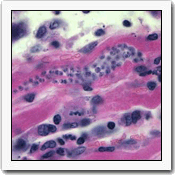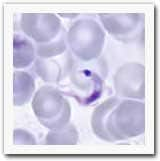The Infectious Agent
Trypanosoma cruzi is the protozoan parasite that causes Chagas disease.
The forms of the parasite are:
- Epimastigotes (replicating form) in the vector’s midgut
- Metacyclic trypomastigotes (infective form) found in the vector’s hindgut and feces
- Circulating trypomastigotes in infected host blood
- Amastigotes (intracellular form) in infected cells of mammalian host tissues
- A key morphologic feature of all forms of the parasite is the kinetoplast, a dense intracellular body

Thin section of heart muscle containing nest of T. cruzi amastigotes. CDC Photo

Trypomastigote form of Trypanosoma cruzi in a thin blood smear. The kinetoplast is the dense body visible at the superior end. CDC photo


